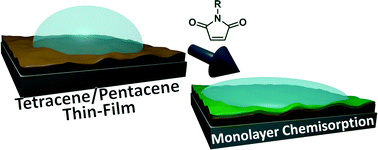Tunable interfaces on tetracene and pentacene thin-films via monolayers†
Abstract
To eliminate many of the traditional weaknesses of thin-film organic semiconductor materials, chemistry has been developed which reacts with the surface of these materials in a manner reminiscent of monolayers on traditional substrates. In the described approach, vapor phase small molecules react with the surface of tetracene and pentacene substrates to form an adlayer via classical Diels–Alder chemistry. The bonding is confirmed via measurement of several coupled vibrations via polarization modulation infrared reflection absorption spectroscopy, which importantly allows for differentiation from physisorbed materials. These films are then used to tune the materials' interaction with overlayers, as measured via a change in the contact angle the surface generates with water.

- This article is part of the themed collection: Crystal engineering of composite materials

 Please wait while we load your content...
Please wait while we load your content...